#star wars analysis
Text
Strap in for the Soresu form III Obi-Wan lightsaber post. This is gonna be a sad one, girlies. We’re getting into Obi-Wan’s Fucking Trauma.
Qui-Gon’s death changed literally everything about Obi-Wan’s life, right down to the lightsaber form. Still a Padawan himself, he had to watch as an extinct monster from his nightmares* utterly took apart the form he’d learned since he was a child, and then, to complete the destruction, slaughtered the teacher who’d taught him the form and raised him. The devastation of Qui-Gon’s actual death had to be the last in a cascading series of horrors that started with the gut-sinking realization that Qui-Gon was losing. And if all of that weren’t enough, Obi-Wan also loses his own lightsaber in the same duel, a psychological blow to his personhood which we don’t have to guess at the significance of. Obi-Wan tells us the cost of it himself in AotC: this weapon is your life.
The Duel of the Fates on a sheer physical level is a devastating thing to consider. It’s a grueling, full out running battle, the likes of which we don’t see elsewhere in the saga. The beauty (and pounding musical score) of the fight distracts from the sheer brutality of it. Maul is physically attacking them at every turn; he manages to kick Qui-Gon hard enough to knock all 6’3 of him off his feet; he dumps Obi-Wan into a fall that seems to be several stories high. We don’t see Obi-Wan get back up off the floor with Qui-Gon’s body at the end of the duel, and I’d be surprised if he was physically able to even stand again so after the adrenaline faded and the soreness and exhaustion took over. He just been whirled in a lightsaber blender.
I can’t imagine how hard it was for him to pick up a lightsaber again after the trauma of that battle - much less, a new, unfamiliar one, not the kyber crystal that had been his since he was a child. The new canon’s emphasis on the spiritual relationship between a Jedi and their crystal makes this detail even more excruciating. The Ataru form itself must have felt broken and unusable. How can you put your trust in a form once you watched it be broken so ruthlessly?
And this is where Obi-Wan is so endlessly beautiful as a character. He goes through this horrifying experience of violent unmaking, and instead of avoiding lightsabers as an understandable trauma response, or picking up an overwhelming power and dominance form like V, he remakes himself into a master of Soresu: a form of simple, complete defense. He doesn’t attempt to become a weapon of attack like Maul did to disintegrate Ataru; he makes himself invincible, untouchable, with a perfect defense. Soresu works the pieces that fell apart for the Jedi in the Duel of the Fates to an advantage. It is a form of ultimate endurance, of playing out your opponent and staying up in a fight until the attacker is exhausted or angry. It preserves and it lasts. It is philosophical. It is considered. It lacks the showy flash of Makashi or Ataru and returns to the basics, even working in some of that battlefield meditation that Qui-Gon so believed in. And in that simple economy, it’s gorgeous and effective.
I have to wonder: is Soresu, on some level, a form of kinetic self-soothing for a person who faced an incredibly traumatic battle at a young age? Does Obi-Wan use it that way?
All of this is perfectly in keeping with the themes of the character. Obi-Wan’s story remains about life, about hope, about survival. The word he uses to describe the Jedi to Luke in the OT is important to me. “Jedi knights were the guardians of peace and justice.” Guardians. And what better lightsaber approach for a person who sees his role as one of protection than a form whose signature move is called “The Circle of Shelter?”
*Maul, of course, is a tragedy in his own right, but that’s a different post.
#star wars analysis#lightsaber nerd stuff#lightsaber forms#qui gon jinn#obi wan kenobi#disaster lineage#the clone wars#duel of the fates#the phantom menace#soresu#darth maul#star wars meta
573 notes
·
View notes
Text
also, about Anakin—I distinctly remember realizing when I was first watching Star Wars that part of what makes Anakin’s relationship with Obi-Wan so compelling is that his love for Obi-Wan is as much forbidden as his love for Padme.
I mean, here’s this kid who’s too old to be trained as a Jedi, not because he’ll be prideful or have to catch up or anything, but because he’s old enough to have already learned how to get attached. And the Council was right; he never, ever unlearns that.

But the very first person aside from Padme that Padawan Anakin got attached to was Obi-Wan. And so all through his training, as he’s growing up and Obi-Wan is growing up too, Anakin is thinking “this is my guy. This is my older brother, this is my best friend, this is the only father I’ve ever known” and just recently discovered that someone like that (Qui-Gonn) can be killed and ripped away from you.
All through his training, that fierce attachment is growing, even more steadily than his love for Padme because he’s never separate from Obi-Wan…and the difference is, Obi-Wan shuts it down. It’s obvious that they love one another like brothers, but Obi-Wan never says it until Anakin is lying like chopped-up charred hibachi on the banks of Mustafar.
I mean, imagine having a father or older brother who you know loves you, but who refuses to say so? Except through his actions, almost in spite of himself?
And then imagine yourself as someone who never gets on board and believes in the code that says you can’t attach? So you know that your father-brother-figure is a hypocrite, about, like, the thing you think is the most important and also the stupidest part of the code?
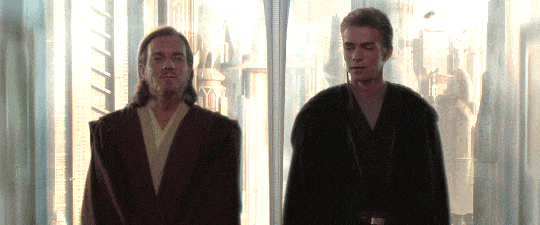
Because he can’t say it! Because he’s supposed to be teaching Anakin not to get attached—what’s he gonna do, tell Anakin “I’m so glad you’re safe” every time they escape an adventure? Tell Anakin he doesn’t know what he’d do if he lost him? Remind Anakin that he cares? And then say “but attachment is bad. Trust the Force.” No, he’s not going to do that. He’s going to keep that aloof-thing going, even though Anakin knows Obi-Wan loves him.
So Anakin, a very dramatic young man who likes his declarations of affection super up-front, never gets that from Obi-Wan. And he’s so sensitive in the Force, and they’re so connected for such a long time—he must be feeling, constantly, that Obi-Wan loves him too. But Obi-Wan never says it. And even though Anakin knows why, it’s a constant source of frustration, because Anakin doesn’t actually respect the code and he doesn’t see why Obi-Wan does.
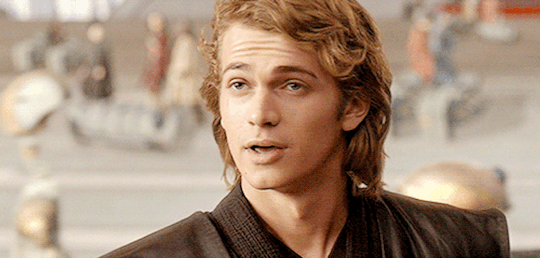
So constantly, Anakin feels like Obi-Wan is hiding affection for him, or withholding it. Keeping something good for him back. He’s feeling like Obi-Wan is, on some level, a little two-faced. He’s feeling like Obi-Wan’s willing enough to save his life and stick up for him—clearly Obi-Wan is attached—but coming out and saying it? Admitting it: “hey little bro, I know you’re attached to me but you have to stop; it’s not the Jedi way. I know how you feel, I’m attached to you too—we’ll just have to figure that out together?”
No, he never does that. Not until it’s way too late, and Anakin has already conflated Obi-Wan’s refusal to express their bond out loud with how deceitful and two-faced the Jedi are, and they have to be enemies.
which, you know, understandable, considering who Obi-Wan is as a character. but still.
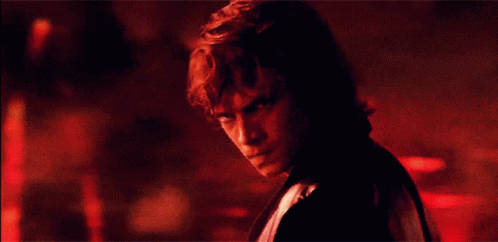
Yeesh. I love this character, I feel like he was when I first started thinking about the tangled web of character motivations and conflicts, but the poor guy.
#Anakin Skywalker#Anakin Skywalker needs a hug#Anakin#Anakin and obi wan#obi wan Kenobi#Hayden Christensen#ewan mcgregor#darth Vader#Ben Kenobi#George Lucas#Star Wars#Star Wars prequels#Star Wars character analysis#saw#sw#the prequels#Meta#Star Wars meta#Star Wars analysis#character analysis#ani
647 notes
·
View notes
Text
On the note of the snippet I posted. Ultimately what makes me go batshit insane about the Sith is that it's truly not about the magic of it all. It's about people being hurt and hurting others in turn.
What it is to become a Sith is to enmesh yourself, forever, in pain. It's at the very forefront of the doctrine, but even ignoring the mentality of it, on the basest level it is about physical and emotional pain. In agreeing to be an apprentice, you're agreeing to years of torture. You're agreeing to anything your master chooses to subject you to; they themselves have suffered as you have and they're chomping at the bit to inflict it upon you too. They have convinced themselves this pain has made them strong, but it has only made them vindictive.
Becoming a Sith is not about becoming powerful. It's about surviving the sheer horror of the training itself and convincing yourself survival is the same as control, that it's the same as power. It's about taking the seething, burning hatred you feel for the person who has tortured you and passing it onto your student, and repeating this for centuries. It's about licking your own wounds, not only the physical but those of centuries of disgraced Sith before you, hiding in the shadiest corners of the galaxy with no one but the person you hate most and believe you owe everything to.
The Sith are fundamentally pathetic, fundamentally impotent, fundamentally miserable, and it simply cannot be extricated from the mess of it all
#at the end of the day i truly can't help but feel bad for them#because damn. get some help. break that cycle. i believe in you#can you tell i've spent WAY too long thinking about the scene in which palpatine is tortured by plagueis and going Oh.#So that's not a palpatine thing huh. that's just a sith thing#personal#star wars#star wars meta#star wars analysis#palpatine#sheev palpatine#sw palpatine#palpatine star wars#star wars palpatine#darth plagueis#darth vader#count dooku#darth maul#sw sith#star wars sith#sith#the force#fandom: star wars#type: meta
423 notes
·
View notes
Text

Me 🤝🏻 being obsessed with Star Wars animals
#the bad batch#the bad batch season 3#the bad batch theories#the bad batch theory#star wars tbb#star wars analysis#star wars spoilers#star wars the bad batch#star wars#the bad batch spoilers#tbb crosshair#tbb batcher#batcher#clone trooper crosshair#sw:tbb#sw#sw tbb
201 notes
·
View notes
Text
Anakin was crying when he told Padme that he genocided the Tuskens. He told her he hated them but he also hated himself.
Star wars is a tragedy because every time you watch it, you think maybe in the back of your mind " it could have been otherwise".Anakin was brilliant and had the potential to be a great person but ended up being one of the worst ones. And he knew it too deep down in his heart but suppressed it as Darth Vader.
Yoda said once you go down the dark path, it will forever dominate your destiny. Anakin believed that there was no coming back. Of course, both omitted the power of love, a power both predictable and unpredictable at the same time.
#star wars#anakin skywalker#Darth Vader#dark force#Yoda#sand people#Lord Vader#padme amidala#queen amidala#senator amidala#luke skywalker#master yoda#light force#jedi#sith#star wars analysis#tragedy#star wars meta#skywalker#sw prequels#anakin x padme#power of love#genocide
256 notes
·
View notes
Text
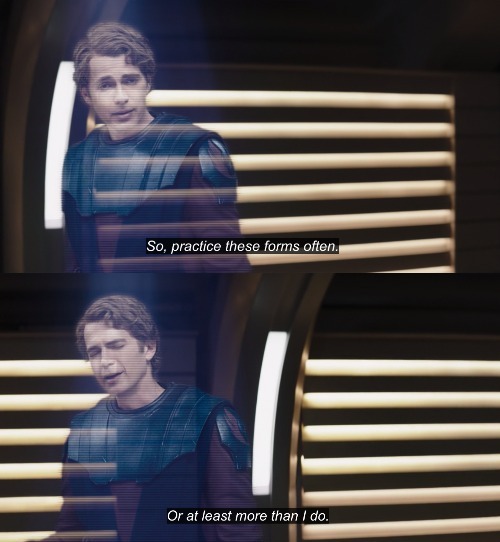
The reason I love this little scene is because it clearly demonstrates why he was such a good mentor to Ahsoka, and why Ahsoka became such a good mentor herself.
The Jedi Order's way of teaching was quite robotic and machine-like, seeing their students as nothing more than an empty vessel to fill with carefully selected knowledge and principles. You see this in how Huyang is programmed and he demonstrates no willingness to adjust or correct his way of teaching.
But what ultimately allows Anakin to help Ahsoka overcome his shortcomings is that he admits he has shortcomings himself. He's essentially telling her "Hey, I'm not the best at this either. But I know that you have the potential to be better than I am."
God, this scene was absolutely perfect.
#anakin skywalker#ahsoka spoilers#ahsoka#star wars#ahsoka series#star wars ahsoka#ahsoka show#ahsoka tv#ahsoka tano#star wars analysis#anakin#sw#jedi
180 notes
·
View notes
Text
Okay so I watched Inside Man on Netflix. It's interesting. More importantly, it's a masterclass in crafting likeable characters and how the POV we follow in a scene affects the way we see a character. Also, this somehow relates to the Star Wars Prequels, I promise! 😆
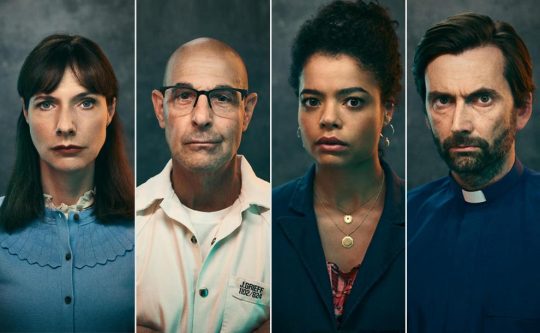
The moral of the series is that "everyone is a murderer, all it takes is a good reason and a bad day." The main characters are:
A vicar who - through a huge misunderstanding - has now locked his son's tutor in his basement and doesn't know how to get out of this situation, played by David Tennant.
A convicted murderer and ex-criminal psychology professor who solves crimes from his cell, as he waits for his execution, played by Stanley Tucci.
So a man who locked a woman in his cellar and a guy who murdered his wife. In any other movie, these guys are the villains. Yet, both of these characters are extremely likeable!
This is achieved through how relatably they behave in their relationships (kind, humble, humorous)...

... and through the emotion and/or charisma brought by the actors playing them (it's THE DOCTOR/CROWLEY and Stanley Friggin' Tucci)... but also through the amount of screen time they get.
We're with them for most of the show. There's other characters (the journalist, the trapped tutor and the vicar's wife) and subplots, of course, but they're our two anchors.
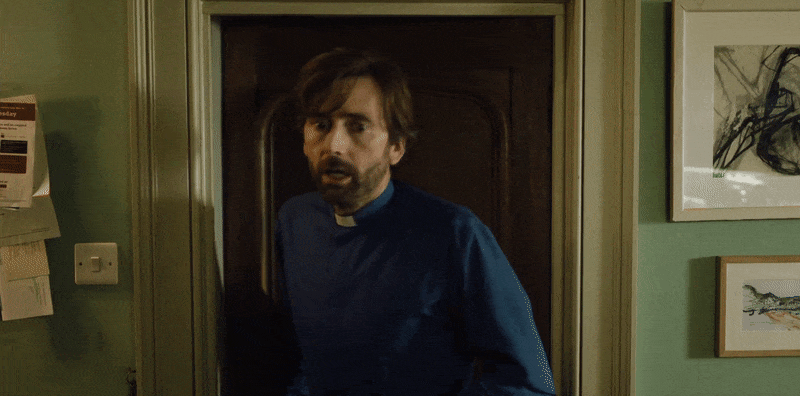
So when I'm watching David Tennant lock his son's tutor in his cellar and consider if he should free her - only to see him and his wife make things worse - I'm not thinking "you monster" like I do when I see Buffalo Bill in Silence of the Lambs for example.
No, I'm thinking "goddammit vicar you're making things worse, it'll come back to haunt you, there's still a chance to turn back, please!" I'm rooting for him to make the right choice because I'm seeing him struggle and despair and hesitate throughout many scenes.

When I'm watching Stanley Tucci guiltily say he deserves death, after being so darn charming, humble and in clear possession of a moral compass, my instinct as a viewer isn't to go "he's right".
It's to go "aaaw, no it's fine, everyone makes mistakes."
And these characters remain likeable and/or relatable for a huge chunk of time... until, every once in a while, the show reminds you that, "remember, these guys are criminals."

"One of them's killed his wife then decapitated her, and the other one is contemplating murder, so they did/are doing evil stuff, they're the villains and you shouldn't grow fond of them."
Then it goes back to making you empathize with them again.
It's quite the emotional roller-coaster, very intriguing yet frustrating, which I have to guess is exactly what the show is going for.
But the point is: the amount of time we spend with these characters is partially what elicits this emotional reaction out of us.
If we consider the tutor's character:
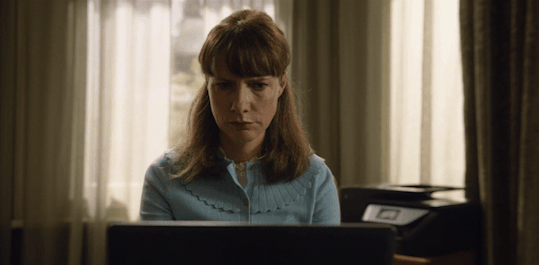
For all intents and purposes, we should feel sorry for her, or full-on fucking love her. Objectively-speaking, she's:
smart but obviously scared,
we establish early on that she has a brave heart and stands up for oppressed women,
she thinks she's trapped by a pedophile or a man defending a pedophile, figures he'll inevitably try to murder her, yet manages to stay resourceful, determined and cool-headed despite it all.
She's an absolute superhero.
But that's not how the narrative frames her.
She's framed as an antagonistic force, in the vicar's subplot.

She may be the one tied up in a basement, but she's in control and the vicar is not. She's almost framed as being in a position of power (when she's really not), which leads the audience to view Tenant's vicar as an underdog.
When the vicar is trying to look for alternatives to end this situation so that he doesn't have to kill her, she's unhelpful,
and even starts pitting the vicar and his wife against each other.
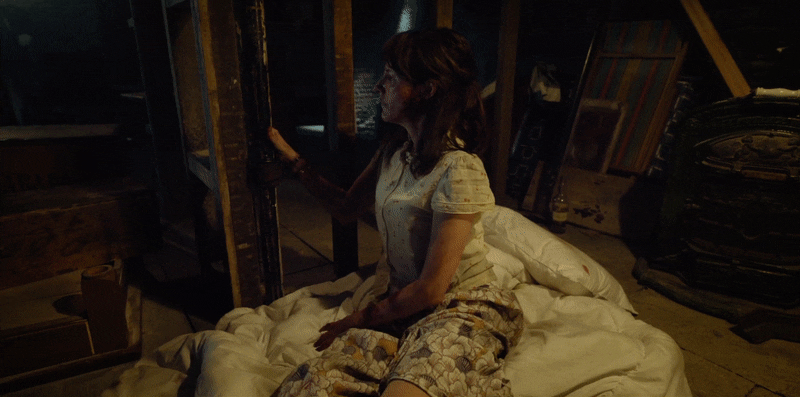
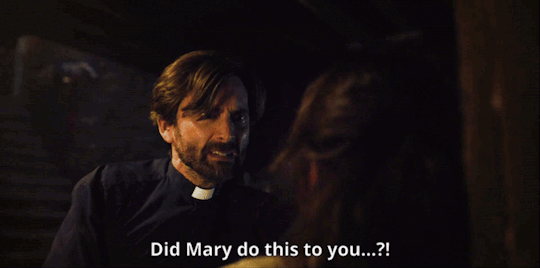
Again, in-universe, she's scared shitless and in "fight-or-flight" mode. She's putting up a front because she's just trying to get outta this alive. She's the victim, here, not the vicar who captured her.
But as a viewer, you don't feel that, despite objectively knowing that. Why and how?
Because we barely see this character, compared to Tenant's vicar. So we have more time to grow to feel for him. There's "why".
Also 90% of what we do see of the tutor is her being aggressive, manipulative, sometimes downright merciless and we're seeing her from the POV of the vicar or the vicar's wife. There's "how".
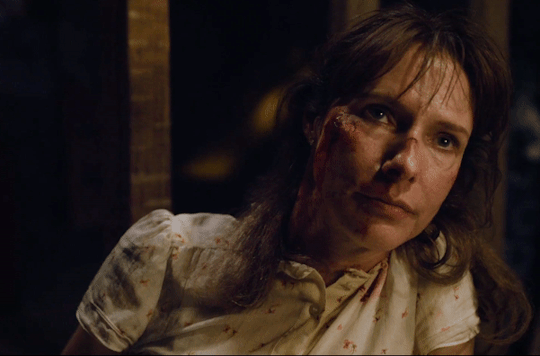
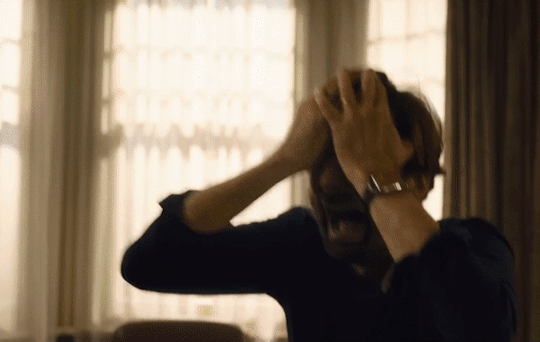
Result: the viewer feels sorry for the captor and frustrated towards the captive.
This isn't a rational reaction, it's an emotional one (the goal of any visual artform being to get an emotional reaction out of the viewer).
Which means the series and Stephen Moffat effectively did their job.
How does this relate to the Prequels?
Well, a lot of people see the Jedi in a negative light in the Prequels, and Anakin in a more sympathetic one.
Even though the Prequels are about how a good man becomes bad, and even though the Jedi embody one of the major Star Wars themes (selflesness) as opposed to Anakin who clearly displays the anti-theme (selfish)... a majority of fans feels more for the latter than the former. Why?
Because the Prequels unintentionally do what Inside Man does purposefully. You react to Anakin like you react to the vicar. You react to the Jedi like you react to the tutor.
Simply put: Anakin has more screen time than the Jedi.
And we don't just see him more, we see him struggle, we see him about what he knows to be morally right vs what he really wants, we see him be overtaken by his own fear...

... and just by contrast, that makes him more relatable than the Jedi, who have already overcome their character arcs and mostly all learned to keep their flaws in check.
The narrative doesn't intend to frame them as antagonistic. We do see them talk about how worried they are, we do see them emote.

And if you think about it, it's easy to see why:
their entire way of life is going to crap,
their values are being corrupted as they're forced to fight and die, alongside their clone brothers, in a war they wanted no part of,
they sense that the Force is close to the breaking point and that the galaxy's inhabitants are suffering on the daily.
But, for example, when Mace or Ki-Adi Mundi are shown expressing concern in the Prequels... as worried as they are, in-universe... out-of-universe, their measured reactions doesn't emotionally impact a viewer as much as Anakin's intense ones do.




So a big chunk of the audience will sympathize more with him than them. But like the tutor in Inside Man, the Jedi are objectively the victims and Anakin is objectively an unstable space-nazi who betrayed and destroyed them.
Just because we're not shown these characters be worried beyond just monotonously saying "I'm worried" doesn't mean they're not actually worried as Anakin is in Revenge of the Sith (if not more).
However we don't see it.
Because these three films aren't about the Jedi Order, they're about the Republic and about Anakin and about how each of these two beautiful things were corrupted (by Palpatine and by themselves) into becoming the very thing they stood against.
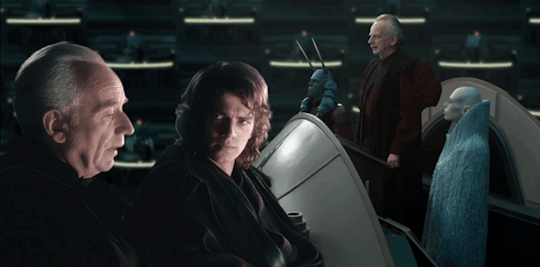

The Jedi aren't a factor in either of those two themes set up by George Lucas.
They became a factor when fans - who despite not liking the Prequels, still admirably chose to engage with the material - made the Jedi be more important to the narrative of the Prequels by re-framing these films as "The Failure of the Jedi".
Now, should Lucas have recognized that most fans wouldn't give two shits about why a Republic falls or the "matinee serial" format, and would've rather he focused on the Jedi, and developed them accordingly? Probably.
But good luck telling an indie filmmaker with a bunch of money how to tell the story he wants to tell.
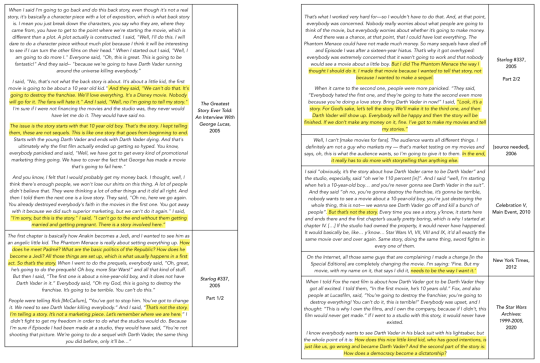
Could Lucas have done more with the Prequels to highlight the fact that the Jedi are the underdogs of the story, not Anakin's oppressors? Yes.
But, firstly, he probably didn't think that was a point that needed explaining. And secondly, as he explained at Cannes, in 2002, feature films are a very limiting format to tell a story, especially one of the Prequels' scale. If it doesn't directly contribute to the story you're telling... it's gotta go.
A limited show would've been better to cover every aspect of the Prequels more in detail and avoid confusing the audience re: who they should be rooting for.
Which is why it's interesting, to me, that Stephen Moffat used his limited show to INTENTIONALLY confuse the audience! 😃
#the screenwriter part of me was geeking out and I had to write this#one of my longest posts and it's about Inside Man of all things wtf#long post#discussion#star wars analysis#meta#SW Meta#Inside Man#inside man bbc#David Tenant#Hayden Christensen#harry watling#Anakin Skywalker#stephen moffat#george lucas#Jedi Order#Jedi Council#Mace Windu#star wars#revenge of the sith#star wars prequels#media#Netflix#BBC#dolly wells
574 notes
·
View notes
Text
One of the most often misunderstood parts of Star Wars is the concept of giving in to the dark side
Too often there's the idea that when you give in, the dark side takes control of you
But it doesn't, it can't, the dark side is not some external force that you allow in
It's just you
The dark side is in you, it's in all of us, it's a terrible part of ourselves, it's the terrible impulses and emotions we feel and must consciously choose to resist
Giving in to the dark side is not someone else controlling you
Giving in to the dark side is when you stop controlling yourself
#wooloo-writes#wooloo writes#star wars#sw#on the dark side#the dark side#sw analysis#star wars analysis#sw meta#star wars meta#philosophy#self control#the human mind#the human psyche
78 notes
·
View notes
Text
“Andor” is doing what I’ve wanted Star Wars to do for years; the Imperial side being humanized. The thing that I loved about “Rogue One” was that it took the unnamed rebels who were always set up as cannon fodder and gave them fully realized identities. They weren’t just extras who get shot at, they were Cassian Andor, Jyn Erso, Baze Malbus, and so on. So, I’ve always wanted to see the same treatment for the Empire since they’re always portrayed as this one-dimensional, evil faction whose troops are also seen as cannon fodder.
We’re getting the humanizing treatment with Dedra and Syril. Yes, they’re working for the Empire, which means they’re our villains. But when you take a step back and look at who they are, they’re not one-dimensional, mustache-twirling bad guys that we typically see in Star Wars.
Imperial officer Dedra is ambitious and has a strong sense of justice, although her meaning of justice aligns with the Empire. Syril is a mama’s boy and a cop who wants to find the man who murdered his subordinates. When our heroes kill off people on their side, they’re rightfully horrified and want to see “justice” be served. That doesn’t mean we have to root for them, but it does make you realize that the Imperials are still people with their own lives and goals. It taps into that “morally grey” tone that the cast and crew talked about, where no one character is fully-good or fully-evil. They’re just people trying to make sense of their lives.
#galactic empire#Star Wars#Andor#dedra meero#syril karn#andor the series#andor tv series#Andor tv#andor spoilers#cassian andor series#cassian andor#rogue one#jyn erso#baze malbus#star wars spoilers#star wars tv#star wars thoughts#star wars imperials#andor star wars#star wars analysis#star wars andor#star wars characters
688 notes
·
View notes
Text
If there’s a legit good reason why Qui-Gon chose to specialize in form IV, Ataru, the Hawkbat lightsaber form, aside from the simple, likely fact that he did it to troll his old Master Dooku (who outright calls the acrobatics of the form “ridiculous,”) I’d like to hear it. By which I mean I’ll write you a post about it.
Ataru is fast, aggressive, and inclined to treat the battlefield as a 3D space where the air is just as comfortable a place to be as on your own two feet. A direct response to Soresu, the “defense is my attack” form, Ataru flips that into “attack is my defense.” (We won’t talk about Makashi’s contribution to the conversation: “no defense whatsoever, but think fast, I just threw a dinner fork at you so hard it stuck in your metal arm!”)
Of course, the most recognizable and classic application of Ataru is Yoda’s; we see him whizzing around people’s heads like a little green hummingbird in his AotC and RotS duels. Qui-Gon’s version looks nothing like that. If we weren’t told, I think it would be hard to guess that those characters are using the same form. In Duel of the Fates, Qui-Gon has to move down or over those infamous walkways repeatedly. He just jumps them: no flips, no aerial maneuvers, no bouncing off the walls. And this isn’t simply a practical choice for his age and build: Jocasta Nu is running up walls and leaping out of skyscrapers at easily aged 40 years older than Qui-Gon, and for all Dooku’s bitching over Ataru acrobatics, he does more flips to simply avoid walking down a few stairs than Qui-Gon, Master of the flip form, does in his entire time on screen.
And yet, on some level, all of that makes perfect sense for Qui-Gon. Who better to completely subvert a form? This is a character who is contrary as fuck, full of wonderful contradiction, who blends lightsaber theory centered on attack and aggression with literal meditation. While the most notable scene, actually kneeling in the pose and everything, is in TPM, he does battle meditation repeatedly on a mental level in the Master and Apprentice and Padawan novels. (And it rightfully freaks out Obi-Wan.) Qui-Gon takes Ataru’s “your whole body is a weapon” and doesn’t apply that to somersaults, but rather, to moves like punching Darth Maul off a balcony as we see him do in Duel of the Fates. He fights in a way that throws himself bodily up against obstacles. You can see the same physicality of his relationship with his weapon in the scene where he is simply burning through the blast doors in TPM. We’ve seen Jedi cut through things on screen other times, but that scene is remarkable and memorable for Qui-Gon’s level of intensity. He is the battering ram.
And we could loop back into lineage, couldn’t we? Qui-Gon stands in a line of Jedi with unconventional relationships to their lightsaber forms; their choices are formed in context of and in conversation with each other. Those backward, momentum-gaining swings from Duel of the Fates look very familiar, but who trained Qui-Gon? (And who notoriously had a problem with Ataru and might've pushed his student on some workarounds or encouraged him to cut out bits he didn't like, such as aerials?) And speaking of, is it a stretch to think that Dooku’s own casual backflips are less a considered choice and more an old habit, being himself trained by a Master who has only a theoretical relationship with gravity?
All this to enjoy just another example of how personal the lightsaber forms can be to specific Jedi, and what wonderful fun it is to unpack the ways they use them differently because of their unique personalities and lineage.
#lightsaber nerd stuff#lightsaber forms#qui gon jinn#count dooku#makashi#ataru#the clone wars#star wars analysis#yoda#the phantom menace#disaster lineage#master dooku
168 notes
·
View notes
Text
currently thinking about Barriss as a foil for Ahsoka in TCW is such a good example of the nature vs. nurture argument. they had basically the exact same upbringing until they were 14 or so, whenever each of them became a Padawan.
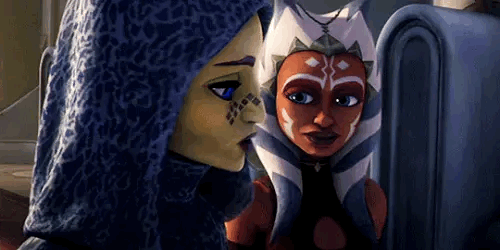
and then in TCW we see Ahsoka with this whole support system or people who love and care about her!! Anakin and Rex and Padmé and Plo and Obi-Wan and more!! and they tell her and/or show her that they care about her!!

and then Barriss has no one, aside from her friendship with Ahsoka. Luminara cares about Barriss to an extent, and she’s certainly not malicious, but she acts at best apathetic toward Barriss. (of course Luminara is just following the Jedi Code as she sees it, but still.) it’s most evident in the Geonosis arc when Luminara is basically ready to just leave Barriss for dead, while Anakin never gives up on Ahsoka. but it goes beyond just Luminara — in TCW, we never see Barriss close to anyone else.

so Barriss is the one who becomes a “villain.” I’m absolutely a Barriss defender, so I don’t want to call her that, but that’s obviously what the writers intended. she turns on the Jedi (understandably) and she turns on Ahsoka. she’s not inherently a bad person, she just didn’t get the love and support she needed, whereas Ahsoka did :(
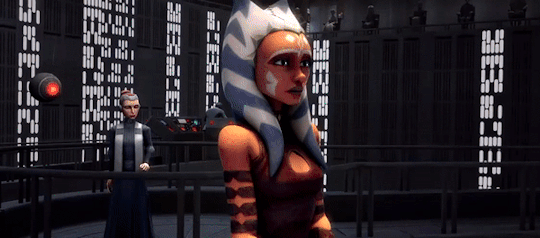
#star wars#the clone wars#star wars the clone wars#star wars analysis#ahsoka and barriss#barriss offee#ahsoka tano#character analysis#idk man#i just rewatched this arc and it makes me incredibly sad#tcw#tcw season 5#gif by jedimasterbailey#gif by fulcrumxsnips#gif by uta-makura#this isn’t touching on all the other complicated stuff about barriss’ character and the problematic elements#like vilifying a muslim-coded character#i really like barriss and ahsoka okay#sky speaks#my posts
138 notes
·
View notes
Text
Thinking about it again, Star Wars Rebels already has kind of established how normal people can interact with the Force (not use it like force-sensitives to be distinct) as long as they’re open to it with Ephram and Mira Bridger.
After Ezra finds out they were killed he has a moment where they do talk to him from the cosmic force and Kanan explains as such, since everyone is part of it.
So then Hera in Ahsoka listening like Jacen asks to find Ahsoka is similar to that.
And a bonus there is also Zeb and Legends of the Lasat with how he directed the Ghost to Lirasan and following the prophecy; engaging with the Ashla for their culture 👀
#ahsoka#Star Wars rebels#Star Wars analysis#ezra bridger#hera syndulla#garazeb orrelios#sabine wren#kanan jarrus#Star Wars#jacen syndulla
93 notes
·
View notes
Text
One thing that really grinds my gears when it comes to the discussion of Rebels is the consistent misrepresentation of Kallus' redemption for ship purposes.
Kallus' redemption arc is not about Zeb. Yes, Zeb kickstarts it, but he did not make Kallus a rebel. And I find it so irritating when people reduce his arc down to "haha he fell so in love he switched sides" like please.
For Kallus' redemption to work, for it to be worth anything, Zeb cannot effectively be a part of it. The entire point of Zeb telling Kallus to search for the answers to questions he hasn't asked is because Kallus needs to see it for himself. He needs to realize for himself. He needs to realize everything he's been a part of.
And that's why I dislike it when people woobify him and turn him into this character who's constantly asking for forgiveness from Zeb. Because even aside from the fact that it's just weird to put Zeb in the position where he needs to constantly forgive the guy who was complicit in his planet's destruction, that's just not what the arc is about.
Kallus looks for the answers. And in the end he's more aware than anyone what he's done, what he's been a part of, and that it needs to be fixed. He's not a soft character and his redemption doesn't change that, it just means that he's changed his actions to be consistent with his morals. Zeb is not guiding him or teaching him or even present for most of it, and that's important.
#i don't have anything against kalluzeb at all i just dislike the presentation of their characters often haha#having the victim of his actions be the one who 'redeems' him is WEIRD!!#and i feel like it's shown well in the show that it's not about that#(also. tangent. don't wanna say that the fandom weirdness is because kallus is white but hello. it's because kallus is white.)#personal#star wars#star wars rebels#sw rebels#garazeb orrelios#aleksandr kallus#star wars zeb#star wars kallus#kalluzeb#star wars meta#star wars analysis#swr#star wars rebels zeb#star wars rebels kallus#star wars rebels meta#fandom: star wars#type: meta
373 notes
·
View notes
Text
Clone Armor and Poster Symbolism in The Bad Batch Season Three
(Brace yourself, loooooong discussion under the cut).
So I’ve long been fixated on the symbolism of the clone’s appearance in Star Wars - it first began in The Clone Wars, with each clone discovering their own individuality and decorating both their bodies and their armor accordingly - think of the Republic crest which decorates both Jesse’s face and his helmet, and becomes a hard-hitting symbol of the end of the Republic which accompanies his death.
In The Bad Batch, clone armor has always been used to symbolize the character’s moral position- initially the main colors of the batch’s armor are black and red, showing both their power, and the element of mystery and otherness that they hold in comparison to standard clone groups. Crosshair’s turn to the empire is shown by him shedding his own armor, and donning a new, entirely black set, with no individuality at all.
In season two, the batch began removing certain sections of their armor and added pieces of a more civilian nature, such as Hunter’s scarf. The pieces of armor that remained were painted a lighter colour, showing that they were gradually leaving their lives as soldiers, or at least those of members of an elite squad, behind them.
In contrast, if you look at a character like Rex, he is still wearing the same armor from his service in the GAR, with only a few minor yet still currently unexplained modifications. He is the one holding onto the past and his service in the army, and it is his identity which drives him to save as many of his brothers as he can.
All of these ideas are particularly apparent in the new season three character posters which have just been released.
Now, while I have previously discussed the idea that the clone assassin is Tech, these posters have me equally convinced that it could actually be Cody.
I believe that Cody has the longest history of any clone in the franchise, being the only clone of any significance in the live-action films, and being prominent in both canon and legends material. As a standard clone, he would most likely have started his commission in the GAR with the general, all white trooper armor, and then decorated it himself as he gained individuality after leaving Kamino. In Brotherhood, the novel which takes place in 22BBY, Cody is described as wearing yellow armor, but, as we see in The Clone Wars, which takes place slightly later, his armor, along with that of the 212th, is more of an orange/gold. This small change could symbolize Cody’s own choice of armor paint being subtly darkened by his experience of war - he is still a loyal soldier of the GAR, but his experiences have changed him.
The orange armor quickly became synonymous with Cody, which is why it was such a shock to audiences to see him with grey armor in The Bad Batch season two. It is a sign that his individuality has been stripped away from him by the empire, but Cody himself still retains the capacity for individual thought and decision making, as shown by his actions in the episode. I also believe that clone armor colors not only symbolize the clones themselves, but also their Jedi generals - the 212th orange symbolized the positivity and energy which came alongside serving under General Kenobi, just as the 501st blue symbolized the freedom and fresh viewpoints of General Skywalker. Therefore, Cody’s grey armor also symbolizes his grief for what he did to Obi-Wan - the man who first provided him the space to discover his own individuality is now ‘dead’ at Cody’s own hand.
I have also long believed that there is a high chance that Cody did not end up escaping at the end of this episode, and was instead captured by the empire for use in experiments.
The release of these character posters seems very deliberate - Star Wars has always been about the battle between light and dark, but due to it’s association with the force, I don’t think we have ever seen clones portrayed in posters in such a manner. The cinematography staff of The Bad Batch have been very vocal recently on the importance of lighting in the show, and I believe that the posters are no exception.
If we look at these poster in order, it is interesting that Wolffe’s seems to be darker than the one featuring Hemlock and Emerie, especially considering how stable he appeared in the past episode.


I believe that this symbolizes that there will be consequences for Wolffe for his decision to let Rex and the others escape, and that he will be subjected to the same treatment which was used in an attempt to change Crosshair, which will leave him the unstable individual we first meet in Rebels.
This idea of placing the clones on a scale from light to dark has me concerned that this season will show the end of Cody’s arc, shifting from the bright white armor he first began with, ending with him wearing the dark armor of a clone assassin.
This idea is only furthered by Rex’s group referring to the clone assassins as ‘shadows’. The reason behind the name is obvious- the clones are shadows of their former selves, having been stripped of all identifying information and individuality.
Considering that Cody’s bright orange armor has long been thought to represent the sun, it would be devastating to see him reduced to an operative with no name and no personality, his only identifying feature being dark armor he would never choose to wear himself. Though I hate to think of it, it does make sense to portray Cody in this way to truly highlight the rise of the empire in the same way Jesse symbolized the end of the Republic - if this theory does turn out to be true, Cody’s arc may have always been intended to show his progression from sunburst to shadow.
#the bad batch#the bad batch season 3#star wars#tbb crosshair#the bad batch spoilers#star wars spoilers#star wars tbb#star wars the bad batch#sw tbb#sw:tbb#commander cody#clone assassin#captain rex#the bad batch theory#the bad batch season three spoilers#star wars analysis#star wars the clone wars#the clone wars#the bad batch theories
104 notes
·
View notes
Text
Anakin/ Darth is the epitome of " I hate you/ I love you". He calls Obi wan wise all the time, then proceeds to call him a failure. He says before their fight that he is what Obi wan made him, yet, in the end, tells him it's not his fault. In my opinion, he acts like a very bitter jilted lover. He never calls him wise in his face, only behind his back. And he doesn't tell him it's not his fault until Obi wan starts crying.
When Palpatine told Anakin to leave unconscious Obi wan behind, Anakin told him that he would have the same fate as them. See, Anakin being immature and very passionate, can't tell himself apart from other people in a healthy way. You are either his enemy or his ally. He'll either die with you or kill you. There's no in between. He'll either rule the galaxy with you or choke you if you deny him ( Padme ). And he knows that he is in pain as much when he hurts the people he loves. More than anything he wants to kill himself. But he'll kill you first because he perceives you as something that's his, an "unfinished business". An egocentric type of love.
He reminds me of the " love me or die" song so much. The narrator/ singer knows that he did something evil ( poisoning and killing his love interest after getting rejected ). He knows that she didn't deserve it, yet, being too far gone like Anakin, believes that there wasn't any other way. In the end, he laments that both of them will go to hell and meet again. In his mind, even tho she is perceived to be the lesser evil, they both sinned and for that, they deserve it.
I believe that's how Anakin perceived his own situation too. He loved Obi wan and he knew Obi wan loved him too ( it's possible that in the song, Matilda loved the narrator but being repulsed by his dirty money and connections, turned him down ).
But in his mind, he wronged him, and Anakin wronged Obi wan too. And for that, they both deserve to die and meet in hell.
It's canon that Anakin felt extremely lonely and empty after killing Obi wan. It's also canon that more than everything he was miserable and hated himself. He was aware of his atrocities. I believe that he thought that he would pay in the afterlife. I believe that he thought Obi wan would be there too, paying for his own sins.
Till Luke came and showed him what true love is like. Non egocentric, more beautiful than ugly, patient, idealistic and forgiving. Darth seeing so many qualities in Luke that reminded him of Padme and Obi wan softened at first his heart a little bit, opening the way for Luke to save him due to his own perseverance in the end.
When Anakin died, he met Obi wan again but not in hell and he accepted that, now knowing how to let go.
#star wars meta#star wars#darth vader#anakin skywalker#luke skywalker#obi wan kenobi#padme amidala#anakin and padme#Vader#force ghost#love me or die#anakin and obi wan#anakin x padme#star wars analysis#i love star wars
86 notes
·
View notes
Text
The Kenobi series really tied the prequel trilogy to the original trilogy in a way that’s never really been done before. Rogue One was just an add on to the OT, and didn't really tie in with the prequels.
The Prequel Trilogy felt like its own story and didn’t ever feel connected to the original trilogy. There's a 20 year gap between them. I mean we saw Luke and Leia at the very end of Revenge of the Sith, and we saw the appearance of Darth Vader, but no real crossover.
'Obi-Wan Kenobi' is that crossover, the connection that has been missing.
We got both Darth Vader and Anakin Skywalker contrasted against each other, the good and the bad, the conflict between them, visible enough that it’s now impossible to forget they’re one and the same. Vader is Anakin and Anakin is Vader. The man in the metal suit is the same man as the hero of the clone wars. The hero with no fear now inspires fear in the entire galaxy.
We got Obi-Wan from the prequels interacting with the two main characters of the original trilogy, Luke and Leia, in a major way. It adds to the storyline, expanding a few plot points we've only had hearsay on. Like why Leia even knows Obi-Wan and why he’s her only hope.
We got the small cameo of Qui Gon Jinn from The! Phantom! Menace!, one of the most disliked SW movies, showing up in this series as the first force ghost! An element that is vital for the original trilogy arc.
We got Bail Organa, who only appears in the prequels, sharing the same screen time as Owen Lars who’s main story line is in the originals. Both fathers of adopted children loving them in the best way they can.
We have Leia saving Obi-Wan from his grief and pain; giving him a new hope that the future might be different. Paralleling the way that Luke saves Vader from his grief and pain and hate; and brings out the last good deed of Anakin Skywalker.
This heartbreaking mini series is the bridge between the beginning and the end, the fall and the rise, the tragedy and the hope. The two separate trilogies have finally become one.
The epic 7 part tale of a father, his two children, and his brother.
The love story of family.
#star wars meta#star wars#obi wan kenobi#sw prequels#sw original trilogy#owk series#userlumi#star wars analysis#owk
681 notes
·
View notes